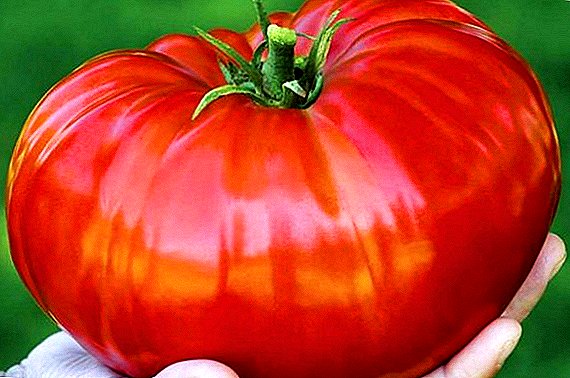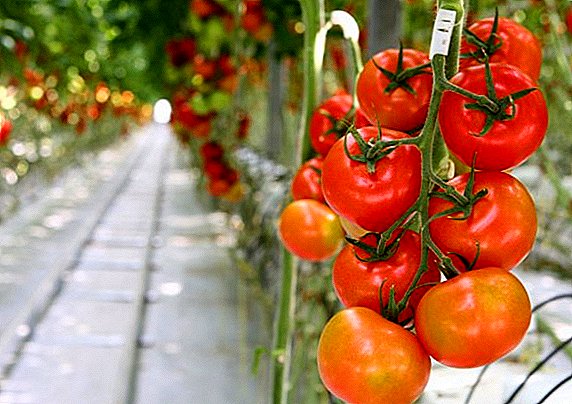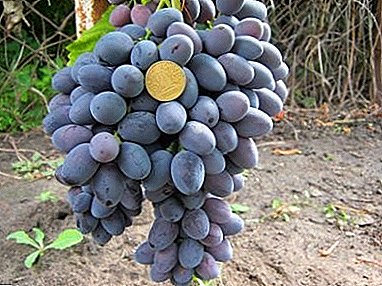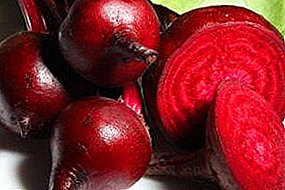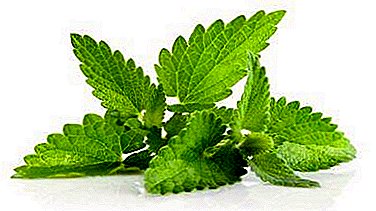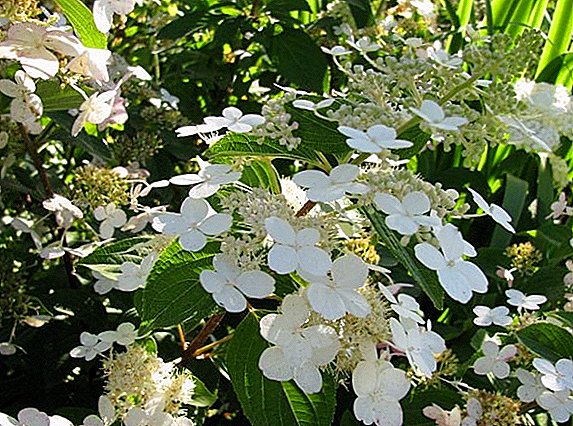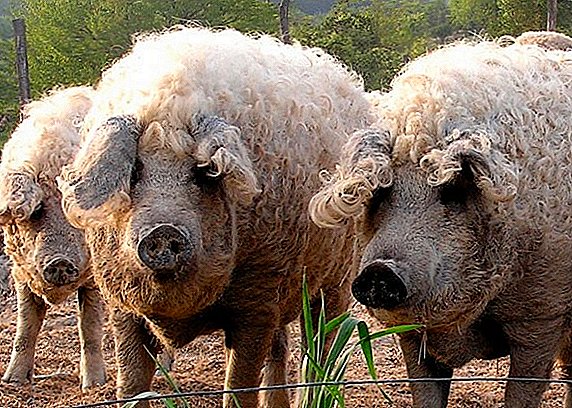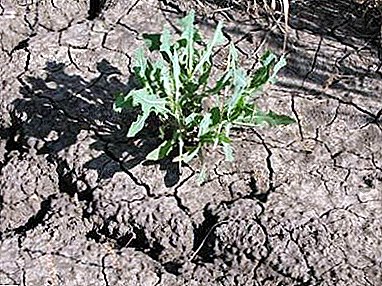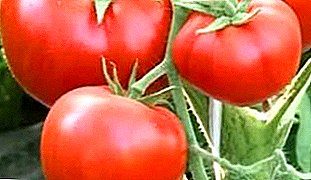
Anyone who loves classic large-fruited tomatoes should try the new variety Snow Leopard tomato. It is suitable for regions with an unfavorable climate, grows well in open beds or under a film cover.
In our article, we offer you a description of the variety, its basic characteristics and characteristics of cultivation.
Tomato "Snow Leopard": description of the variety
| Grade name | Snow Leopard |
| general description | Early ripe, determinant, high-yielding variety of tomatoes |
| Originator | Russia |
| Ripening | 100-110 days |
| The form | Rounded flat, ribbed at the stem. |
| Colour | Red orange |
| Average tomato mass | 120-140 grams |
| Application | Canteen, for canning |
| Yield varieties | 2-3 kg per square meter |
| Features of growing | Tomatoes are grown in both seedling and seedless way. |
| Disease resistance | Resistant to major diseases |
 The Snow Leopard is a high-yielding early ripe variety. The bush is determinant, perfectly leafy. (About indeterminantny grades read here). The leaf is dark green, large, the fruits ripen with brushes of 4-4 pieces. Despite its compactness, the plant needs to be formed in 1-2 stems, heavy branches will have to be tied up. Productivity is good, from 1 plant you can collect 2-3 kg of selected tomatoes.
The Snow Leopard is a high-yielding early ripe variety. The bush is determinant, perfectly leafy. (About indeterminantny grades read here). The leaf is dark green, large, the fruits ripen with brushes of 4-4 pieces. Despite its compactness, the plant needs to be formed in 1-2 stems, heavy branches will have to be tied up. Productivity is good, from 1 plant you can collect 2-3 kg of selected tomatoes.
Compare the yield of tomatoes Snow Leopard with others can be below:
| Grade name | Yield |
| Snow Leopard | 2-3 kg from a bush |
| Gulliver | 7 kg from a bush |
| Pink Lady | 25 kg per square meter |
| Fat jack | 5-6 kg from a bush |
| Doll | 8-9 kg per square meter |
| Lazy man | 15 kg per square meter |
| Black bunch | 6 kg from a bush |
| Rocket | 6.5 kg per square meter |
| Brown sugar | 6-7 kg per square meter |
| King of Kings | 5 kg from a bush |
Fruits are moderately large, weighing 120-140 g. The color is saturated red-orange. The shape is rounded-flat, with noticeable ribbing at the stem. The taste is bright, not watery, sweet with a barely noticeable acidity. The flesh is low seed, juicy, fleshy. High content of sugars and beneficial amino acids.
The weight of the tomato fruits of the Snow Leopard with other varieties can be compared in the table below:
| Grade name | Fruit weight |
| Snow Leopard | 120-140 grams |
| Bobcat | 180-240 grams |
| Russian size | 650-200 grams |
| Podsinskoe miracle | 150-300 grams |
| Altaic | 50-300 grams |
| Yusupovskiy | 500-600 grams |
| De barao | 70-90 grams |
| Grapefruit | 600 grams |
| Prime minister | 120-180 grams |
| Stolypin | 90-120 grams |
| Buyan | 100-180 grams |
| The president | 250-300 grams |
| Lazy man | 300-400 grams |
Origin and Application
The variety of the Russian selection, is recommended for cultivation in an open ground or under a film. Suitable for regions with a temperate or northern climate, not afraid of weather extremes: droughts, gifts, short-term frosts. High yield, harvested fruits are well stored, suitable for transportation.
Tomatoes are suitable for cooking and canning.
 Read also on our website: How to grow a lot of tasty tomatoes all year round in greenhouses? How to get a great harvest in the open field?
Read also on our website: How to grow a lot of tasty tomatoes all year round in greenhouses? How to get a great harvest in the open field?How to care for early ripening varieties? What varieties have good immunity and high yields?
Advantages and disadvantages
Among the main advantages of the variety:
- excellent taste of the fruit;
- high yield;
- fruits are suitable for salads and canning;
- resistance to major diseases: Fusarium, Alternaria, Verticillus, tobacco mosaic;
- tolerance to adverse weather conditions;
- Tomatoes are well stored.
The only drawback can be considered the need to form a bush and remove the side processes.
A photo
Let's take a closer look at the Snow Leopard tomato on the photo:



Features of growing
Tomatoes multiply both seedling and seedless. Seed material is recommended to fill growth stimulator for 10-12 hours. In the seedling method, seeds are sown in containers with nutrient primer. The ideal composition is a mixture of garden or sod land with humus and washed river sand. For greater nutritional value, it is worth adding a little superphosphate and wood ash. Read also about the types of soil for tomato, about the soil for adult plants in greenhouses and how to prepare their own soil mixture.
Seeds are sown with a depth of about 2 cm, sprinkled with peat on top and sprayed with warm water. After the appearance of germs, the containers are exposed to bright sunlight or under lamps. The brighter the light, the better the plants grow.
When the first pair of true leaves unfolds, the seedlings spike in separate pots. Then the young plants are fed with complex mineral fertilizer. Transplantation for permanent residence begins in the second half of May. If it is decided to plant a tomato in a seedless manner, the seeds are placed directly in the wells, watered with warm water and covered with foil. For the season, the plants need 3-4 times to feed the full complex fertilizer.
If desired, it can be alternated with organic matter: diluted mullein or chicken droppings.
- Yeast, iodine, ash, hydrogen peroxide, ammonia, boric acid.
- Mineral, phosphoric, ready, foliar, TOP best.
Watering plants should be abundant, but not too often, the top layer of soil should have time to dry. Compact bush does not require tying, but if the branches become too heavy, you can attach them to the supports. Extra side shoots and leaves are removed, it improves air circulation and stimulates abundant fruiting. Mulching will save from weeds.
Pests and diseases
 Variety resistant to major diseases, but plants may be infected by other tomatoestherefore, preventive measures are necessary. Before planting, the top layer of soil is updated, a fresh portion of humus is added. Read more about how to prepare the soil in the greenhouse for planting tomatoes in this article.
Variety resistant to major diseases, but plants may be infected by other tomatoestherefore, preventive measures are necessary. Before planting, the top layer of soil is updated, a fresh portion of humus is added. Read more about how to prepare the soil in the greenhouse for planting tomatoes in this article.
For greater safety, the soil can be shed with an aqueous solution of potassium permanganate or copper sulfate. Some problems can be solved with the help of timely supplements. For example, brown soft spots at the stem indicate a lack of potassium in the soil. Too small fruits can be the result of phosphorus deficiency. Airing, weeding and soil loosening will protect from rot. The soil can be thrashed with straw or peat.
Read more about the most common diseases of tomatoes in greenhouses and measures to combat them, as well as about blight, protection from it and varieties that do not suffer from blight.
As for pests, Colorado beetles and their larvae, aphids, thrips, spider mites most often threaten tomatoes. On our site you will find articles about how to deal with the Colorado potato beetle, get rid of aphids and thrips, to prevent the appearance of spider mites. If the problem becomes too large, use insecticides.
The Snow Leopard is an ideal choice for gardeners who have not yet acquired a greenhouse and cannot grow delicate heat-loving varieties.
Unpretentious and fruitful Leopard will provide a good harvest, the fruit can be canned or used for culinary experiments.
In the table below you will find links to varieties of tomatoes with different ripening terms:
| Middle late | Early maturing | Late-ripening |
| gold fish | Yamal | Prime minister |
| Raspberry wonder | Rose of Wind | Grapefruit |
| Miracle of the market | Diva | Bull heart |
| De Barao Orange | Buyan | Bobcat |
| De Barao Red | Irina | King of Kings |
| Honey salute | Pink spam | Grandma's Gift |
| Krasnobay F1 | Red Guard | F1 snowfall |


